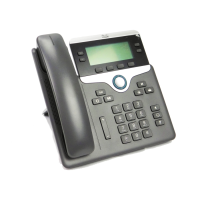Usage NotesPurposeNetwork Protocol
DHCP is enabled by default. If
disabled, you must manually
configure the IP address, subnet
mask, gateway, and a TFTP server
on each phone locally.
We recommend that you use DHCP
custom option 150. With this method,
you configure the TFTP server IP
address as the option value. For
additional supported DHCP
configurations, see the
documentation for your particular
Cisco Unified Communications
Manager release.
If you cannot use option
150, use DHCP option 66.
Note
DHCP dynamically allocates and assigns
an IP address to network devices.
DHCP enables you to connect an IP
phone into the network and have the
phone become operational without the
need to manually assign an IP address or
to configure additional network
parameters.
Dynamic Host
Configuration Protocol
(DHCP)
Cisco IP Phones use HTTP for XML
services, provisioning, upgrade and
for troubleshooting purposes.
HTTP is the standard protocol for transfer
of information and movement of
documents across the Internet and the
web.
Hypertext Transfer
Protocol (HTTP)
The Cisco IP Phone implements the
IEEE 802.1X standard through
support for the following
authentication methods: EAP-FAST
and EAP-TLS.
When 802.1X authentication is
enabled on the phone, you should
disable the PC port and voice VLAN.
The IEEE 802.1X standard defines a
client-server-based access control and
authentication protocol that restricts
unauthorized clients from connection to
a LAN through publicly accessible ports.
Until the client is authenticated, 802.1X
access control allows only Extensible
Authentication Protocol over LAN
(EAPOL) traffic through the port to
which the client is connected. After
authentication is successful, normal
traffic can pass through the port.
IEEE 802.1X
Cisco IP Phone 7800 Series Administration Guide for Cisco Unified Communications Manager
11
Supported Network Protocols

